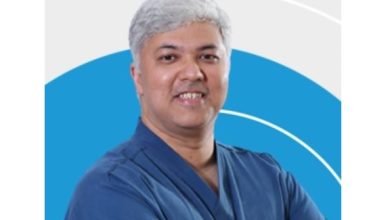
Fundamental research, innovations and the concept of create-in India can be a game-changer in cancer care.
Dr Vishal Rao, Associate Dean, Centre for Academics and Research, HCG Cancer Hospital Bengaluru
When we talk of the future of cancer, we essentially think of the next decade which holds the responsibility of bridging the gap between biological advances and technological advances. To bridge this glaring divide between the two progressions, we will need to define targets and timelines under four broad heads: advances in molecular biology, cancer research, cancer moonshot initiative for India and cancer technologies aimed at prevention, detection and cure.
Cancer in Perspective
Currently, in India, cancer is one of the leading causes of mortality, and the overall survival rate is poor as most cases are presented at an advanced stage. Worse, the best of recent advances have made a trifle impact on outcome outcomes in the vast majority of cancers. Even the global statistics of 24 top cancers are not heartening
on this count, as the curative ordeals have been far from the game-changer they were expected to be. By 2030, a significant rise is expected in the number of cancer cases, given the double blow at play. On one hand, tobacco and alcohol abuse is rampant, on the other, the use of preservatives, pesticides, chemicals, and adulterants in our food is playing havoc with our minds and bodies.
Conscious Capitalism
Our current focus in cancer care should hence be on designing a comprehensive plan that addresses a ‘Prevention to Palliation’ approach while stressing on prevention. After prevention, the next best strategy is early detection. These two need to be at the top of the pyramid in our fight against cancer. More importantly, we need to adopt a societal approach to address this cancer epidemic which could graduate into a pandemic in the coming years if left unchecked. If we look around us, we increasingly find society itself developing a cancerous mindset, thanks to the reigning vulture capitalistic approach. We simply want more and more of everything, virtually driven to despair by the “buy one, get three free” frenzy in every purchase, whether tobacco, alcohol or adulterated food.
The only way we can add value and meaning to replacing the vulture capitalist approach by conscious capitalism. And towards this effect, the WHO, federal and state governments would need to invest more in cancer prevention strategies, else healthcare costs are only going to rise exponentially. The 19th century was for dynasties, 20th for the federal government, but the 21st century will belong to states and cities to take decisive actions on healthcare.
Statistical outliers in cancer and science of healing I wish to allude to a patient of mine, a 67-year-old lady who came to me with an aggressive cancer of the mouth, a sarcomatous carcinoma of the maxilla. Post an eight-hour surgery, when she came back in a month for radiation and chemo, the tumour had recurred both in the lungs and local area. The patient was now in a wheelchair, unable to walk on her own. Despite the seeming futility of further treatment given the poor prognosis, I briefed the patient about metronomic chemotherapy – a low-dose chemo variant founded on the simple premise that if you cannot demolish a building at one go, try to remove one block at a time. I gave her the needful tablets and requested to keep me updated through regular follow-ups. One and a half years later, the family came to report that she was back to normal life. A PET scan showed no tumour this time around. This case was nothing short of a game-changer given its extraordinary significance in shaping the direction of future cancer therapies.
Small is Equally Big
Typically, in aggressive cancers, on a chart showing stage-wise survival rates at diagnosis, where X-axis denotes survival time intervals and Y-axis shows tumour growth in per cent, the tumour never exactly touches the Y-axis, thanks to the statistical outliers, people who beat the statistic, despite being pitted against the bulk of cases which go from bad to worse. However, given the customary focus on big data, we lose sight of the small data, which is a priceless pointer to where we went right in an ocean of wrong. To me, this tiny, minuscule minority is integral to scientific advancement as it will lead the alterations and tweaks in major protocols where we have been failing recurrently.
Ground shot and Moon shot
In 2016, Joe Biden set up the Blue Ribbon Panel with the NIH support that kicked off the cancer moon shot, a brilliant, billion-dollar initiative targeted at the core areas of cancer equipped with five weapons: enabling technologies, immunotherapy, precision medicine, personalised medicine, and Big Data. I believe India should
spearhead its cancer moonshot initiative. We should be at the forefront of oncology research making our discoveries. In the case of the lady mentioned above, precision medicine and personalised medicine worked wonders with the difference that my focus here was both on big and small data. This is the highly patient-centric moon shot that we need to unleash in India.
In the context of these five areas, I am reminded of Moses Judah Folkman, best known as the father of angiogenesis, and perhaps the one who has significantly contributed to advances in tumour angiogenesis. He wondered long back whether we will reach a point in history when we can peacefully coexist with our tumours. In other words, one won’t have to kill the other in an elusive zero-sum game if cancer could be made akin to diabetes or hypertension. This is the moon shot we need to work towards, of making cancer a truly chronic disease. Precisely why, while we aim for the moon shot, we also need to look at the ground shot to make cancer treatment easily accessible at the grassroots level.
Gene side and Bedside Medicine
Biomarkers are characteristics of tumours that can be measured objectively as indicators of a pathological process or therapeutic response. In the course of my research, I have proposed the immune TNM staging in oral oncology. T stands for T-cells, N for neutrophils, and M for macrophages that together help predict the progression of a disease. Till now, the whole focus of cancer staging systems has been on tumour node metastasis, given that tumour starts at a particular area, spreads to the lymph nodes and later to other organs.
The new staging systems must necessarily study the immune system. Why? Because even cancer of the same stage does not necessarily behave the same way in all human bodies. Stage I cancer in one person may approach cure, while in another body, it may necessitate a protracted treatment, and in a third body, it may spread beyond cure. This is the reflection of the denominator in the immune system, not merely the nominator. A probe into genomics, proteomics, and metabolomics will lead to gene side medicine complimenting bedside medicine.
Microbiology of the Cancer Biology
Simply put, Genomics helps us know who we are. It is the horoscope of the gene which makes some startling revelations about the truth of the human body. We house 23000 active genes, while the genes in one grain of rice amount to 55,000. So, if we think we are highly evolved, we seriously need to take an introspective break. In this context, epigenomes assume critical significance as they help answer the key question: Who controls our genes – who turns the switch on and off? More important than the switch is the controller of the switch. The controller can be our minds, the food we consume, or the air we breathe – which is another reminder of why we need to take care of our environments, curb our addictions, balance our diets, and be wary about the pesticides and adulterants that may be killing our good microbes, much against the assumed metaphor of war- ‘the only good bug is a dead bug’.
Studies show that while our human genome is relatively fixed, we are truly defined by the other contagious genome, which is the microbiome. We have 100 trillion microbial cells housing 20 million microbial genes present since birth.
At HCG, we are working on finding whether there is an oncobiome? Are there any bad microbes that cause cancer? One of my recent projects in oral cancers revealed the possibility of a few bad microbes playing a causative role in creating the oncobiome with parallel depletion in good ones. So, the field of microbiology has now shifted from observing these microorganisms under the microscope to studying their genetic trails. You cannot see viruses under the microscope, but their DNA materials can well be traced. Most microbes are good bugs, but we need to track the minority of bad bugs too, as they could represent the true reflections to our immune system.
Size, Seed and Soil
While studying a tumour, we are invariably size-fixated. Bigger the size, advanced the stage, and larger the capacity to invade is the current dictum. At HCG, we are exploring the depths of non-invasive methods for diagnosis and one such way is the circulating tumour cell clusters known as liquid biopsy. Our probe seeks to answer the question: Can we come to a stage where we can pick up and predict various cancers from the circulating tumour cells or even earlier? Can we track the cancer cells in the circulation itself while it plans its spread? Our ongoing research has shown that while a person of stage one cancer had aggressive circulating tumour cell clusters in his blood, a stage four person’s circulation showed none. So, the very perspective of looking at a stage based on size may be flawed as there are biological signatures and factors beyond mere size alone, which have been laid less emphasis on. The fundamental relearning that has to happen in oncology is through revalidating some of our prior assumptions through research. The concept of seed and soil has been central to the assumptions – from the early 50s, we have believed that seed is more important than the soil. It is the seed that will cause the tumour to proliferate. But over the years, we have understood that the soil is equally important – that seed cannot germinate without the right soil. Today, we have gone one notch above to find that the seed carries with it its own soil, and could be more important than the seed. If the soil is fertile and ready, it could attract the seed to itself. Once the circulating tumour cells originate, the soil will call for it. It will create a climate to attract the seed like a magnet. That is what we have known through the microenvironment, and at HCG, we have developed the Tumour Immune Micro Environment (TiME) score.
Create in India based on Fundamental Research
It has been conventionally believed that genomics alterations lead to changes in proteomics and metabolomics. But what if there was another route? Rather than looking at a constitutional defect, why not look for an extrinsic action of various carcinogens that we are exposed to? We have recently published a paper where I have hypothesised that cancer can be predicted through the understanding of physics, chemistry, quantum physics and mathematics which will fuel a quantum leap in our understanding of cancers.
Digital diagnostics, IoT and the cloud, ultra-fast scans, wearables, blockchain, digital therapy, big data, nano health, AI health, hackathons, system learning and robotics, these 12 technologies will form the foundation and future of oncological targets to make cancer treatment accessible and cancer more affable, in the sense
of coping with it like a chronic ailment rather than succumbing to its identity as a killer disease. Unfortunately, India’s GDP spending on research is negligible. We are largely content with replicating and revalidating the West rather than innovating and originating. That’s why we need to look beyond ‘Make in India’ to ‘Create in India’ based on improved crosstalk between fundamental research and innovations, on the lines of the approach taken by BIRAC-Dept of Science and Technology, Govt of India. This would call for substantial investment both from private and public bodies, a grand collaboration to bring academia and industry rooted in lateral thinking across diverse areas of expertise.





